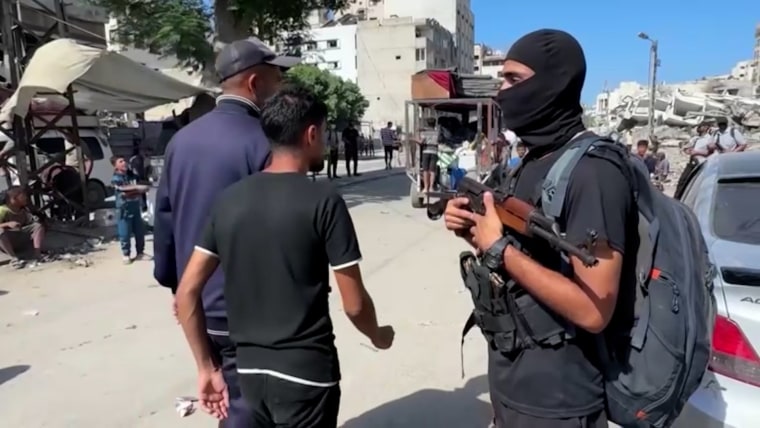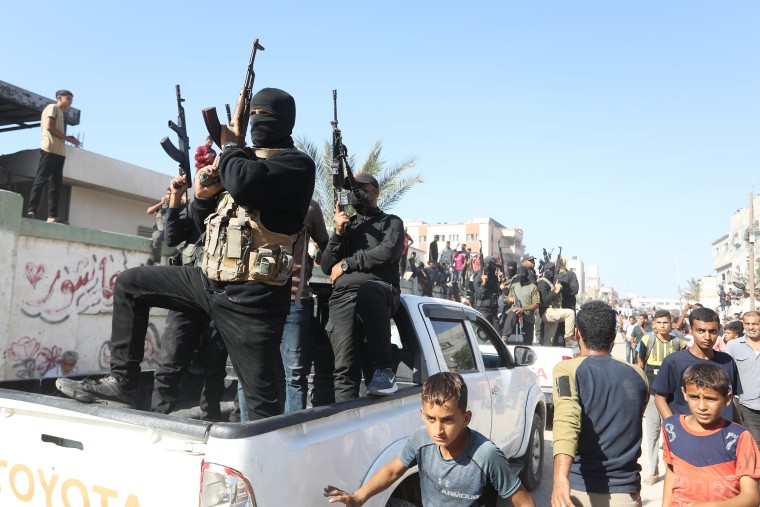Violence between Hamas and gangs erupts in Gaza amid Trump ceasefire

As Israel withdrew from Gaza last week, Hamas intervened, with violence marked by at least one public execution and clashes with rival factions as the militant group tried to regain control under the ceasefire in the war-torn territory.
The message was clear: we are still here.
Disarming Hamas is the most critical and difficult to implement part of President Donald Trump’s peace plan, analysts say.
But Gaza is home to many militant clans and groups, and score-settling and crime pose a threat to order in the Palestinian enclave, even after the ceasefire.
A video obtained by Reuters this week appears to show masked gunmen executing several men on a street in Gaza City. In the footage, at least six people could be seen forced to their knees with their shirts pulled over their heads before being shot.
In other images, at least two of those carrying out the executions appeared to be wearing the green headbands typically worn by Hamas’ military wing, the Qassam Brigades. NBC News verified the video’s location in Gaza, but did not confirm that the men shown were Hamas members.
Hamas did not immediately respond to a request for comment on the incidents. Last month, before After the current ceasefire, Hamas-led authorities said three men had been executed after being accused of collaborating with Israel, Reuters reported at the time.
President Donald Trump issued a clear warning about violence on Thursday.
“If Hamas continues to kill people in Gaza, which was not the agreement, we will have no choice but to go there and kill them. Thank you for your attention to this issue!” he posted on Truth Social.
Asked at a news conference if he meant U.S. troops could be involved, Trump said: “It won’t be us. We won’t have to do it. There are people very close, very close who will come in. They will do it very easily but under our auspices.”
Following the initial withdrawal of Israeli troops from parts of Gaza, Hamas, which has ruled the enclave since 2007, attempted to regain control, with the militant group’s internal security organization issuing an appeal urging residents to report “wanted individuals”, including Israel’s “collaborators”.
Israeli Prime Minister Benjamin Netanyahu confirmed earlier this year that Israel had “activated” clans opposed to Hamas, designated a terrorist organization by the United States. His comments come after Israeli media, including the Times of Israel, reported that he had authorized the supply of weapons to a particular group in southern Gaza, citing defense sources.
Calling on Hamas on Wednesday to “suspend violence” in the enclave, CENTCOM Commander Admiral Brad Cooper said the truce brought by Trump’s 20-point ceasefire plan marked a “historic opportunity for peace.”
“Hamas should seize it by withdrawing completely,” he said.
Trump’s warning Thursday followed comments earlier in the week in which he appeared to downplay the violence in Gaza, saying Hamas had taken out “a few gangs that were very bad,” before adding, “that didn’t bother me much.”
This week’s bouts of violence came as the United States and Israel continued to call for the disarmament of Hamas, a key stipulation of Trump’s plan and a long-standing sticking point in negotiations for a lasting truce.

The Israeli army has been accused of repeatedly opening fire on Palestinians this week amid the truce. The Israeli military on Tuesday acknowledged an incident in which it said soldiers opened fire on people who approached forces stationed along the withdrawal line agreed to under the first phase of Trump’s plan, which it said was a violation of the deal.
Michael Wahid Hanna, director of the U.S. program at the International Crisis Group, a global nonprofit based in Brussels, said there was still a lack of clarity on how the disarmament of Hamas might actually take place.
“None of this has been clarified: what type of weapons, under what conditions… none of this. None of this is on paper,” he said. “It’s kind of an ambitious end point, without a lot of signposts on how to get there.”
What is clear, Hanna said in an interview Wednesday, is that “Hamas is not gone.”
“I mean, a lot of people have been saying this for a long time, that Israel wouldn’t be able to eliminate or destroy Hamas, and they haven’t,” Hanna said.
“They have probably eliminated Hamas as a real threat to Israeli security, but as far as Hamas in the Gaza Strip is concerned, they are still there and apparently exert some consistent control,” he said, noting that some of the violence appears to be “related to clan crime,” including clans with “ties to Israel.”
Members of a number of clans in the enclave have clashed with Hamas over the past two years, including the Abu Shabab clan, led by Yasser Abu Shabab, whom Hamas has accused of collaborating with Israel. The Doghmosh clan, one of the largest and most powerful in Gaza, is also in conflict with Hamas.

Reuters reported that Hamas fighters clashed with Doghmosh members on Sunday and Monday, citing security sources. NBC News was not immediately able to verify this information.
“There are some well-known clans and personalities,” Hanna said. “Anyone at this point who tries to operate independently outside of Hamas authority in places where it has a presence is probably going to have problems.”
In a statement released Tuesday following a gathering of Palestinian tribes and clans in the Gaza Strip, some clans warned that protection would be withdrawn from any member “proven to be involved in any violation threatening our societal security and civil peace.”
They urged the groups to “fully adhere to this decision” to maintain peace and to “hand over the perpetrators and violators to the competent authorities,” in an apparent reference to Hamas.
“I think it was a stupid strategy on Israel’s part to try to rely on some of these clans,” said Ahmed Fouad Alkhatib, director of Realign for Palestine, a project of the Atlantic Council. “Hamas made a name for itself early on by breaking up a lot of these clans and having the ability to say we’re bringing law and order.”
The gang violence in Gaza comes as peace efforts have also been complicated by Hamas’ failure to return many of the bodies of the 28 hostages killed in captivity.
Hamas said Wednesday that the remaining bodies required “significant effort and specialized equipment to search and recover.”
Israeli Defense Minister Israel Katz has asked top commanders of the Israel Defense Forces to prepare a military plan to defeat Hamas if the militant group refuses to implement the U.S.-brokered peace plan, according to Katz’s spokesperson.




